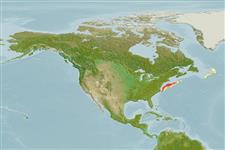Classification / Names
आम नाम | उपशब्द | Catalog of Fishes(वर्ग, प्रजाति) | ITIS | CoL | WoRMS | Cloffa
Environment: milieu / climate zone / depth range / distribution range
पारिस्थितिकी
समुद्री; गहराई सीमा 500 - 674 m (Ref. 53592). Tropical
North Western Atlantic: off Cape Hatteras.
आकार / वज़न / Age
Maturity: Lm ? range ? - ? cm
Max length : 3.7 cm SL पुल्लिंग / अलिंग; (Ref. 53592)
Short description
आकृति विज्ञान | मौरफोमैटरिक्स
पृष्ठीय सौफट रेज़ (सम्पूर्ण): 42-44; ऐनल सौफट रेज़: 33 - 35; जानवरों की रीड़ का जोड़: 47. The juvenile holotype of this species is distinguished by the following characters: vertebrae 47; dorsal-fin rays 42-44; no coronal pore; vertical mouth, symphysis of upper jaw above level of eye; body not humpbacked; vertebral column not curved behind cranium; enlarged gill cavity; anus on vertical behind head; notched pectoral fin, rays 8+2+5-6; eye 17-19% HL (Ref. 53592).
The species possess a very large superior mouth with vertical jaws, eyes located close to the dorsal contour of the head and oriented to look forward and up, and a straight body, suggesting an adaptation to feeding on detritus and animals (such as copepods) above it in the water column (Ref. 53592).
Life cycle and mating behavior
परिपक्व अवधि | पुनरुत्पत्ति | मछलीऔ का अंडे देना | अंडे | Fecundity | लार्वा
Chernova, N.V. and D.L. Stein, 2004. A remarkable new species of Psednos(Teleostei: Liparidae) from the western North Atlantic Ocean. Fish. Bull. 102:245-250. (Ref. 53592)
IUCN Red List Status (Ref. 130435)
Threat to humans
Harmless
Human uses
अधिक जानकारी
आम नामउपशब्दचपायचयपरभक्षीईकोटोकसीकोलौजीपुनरुत्पत्तिपरिपक्व अवधिमछलीऔ का अंडे देनाSpawning aggregationFecundityअंडेEgg development
Age/Sizeबाढ़Length-weightLength-lengthLength-frequenciesमौरफोमैटरिक्सआकृति विज्ञानलार्वालारवल गतिकीभर्तीबहुतायतBRUVS
संदर्भजलीयकृषिजलीयकृषि रूपरेखाखींचआनुवंशिकीElectrophoresesहैरेटिबिलटीबीमारीप्रक्रमणNutrientsMass conversion
सहयोगीयोतस्वीरेStamps, Coins Misc.ध्वनिसिगुयटिरारफ्तारतैरने के प्रकारगिल क्षेत्रOtolithsदिमागदृष्टि
साधन
Special reports
Download XML
इंटरनेट स्रोत
Estimates based on models
Preferred temperature (Ref.
123201): 3.4 - 4, mean 3.6 °C (based on 29 cells).
Phylogenetic diversity index (Ref.
82804): PD
50 = 0.5000 [Uniqueness, from 0.5 = low to 2.0 = high].
Bayesian length-weight: a=0.00525 (0.00237 - 0.01161), b=3.15 (2.96 - 3.34), in cm total length, based on LWR estimates for this (Sub)family-body shape (Ref.
93245).
Trophic level (Ref.
69278): 3.2 ±0.5 se; based on size and trophs of closest relatives
Fishing Vulnerability (Ref.
59153): Low vulnerability (10 of 100).
